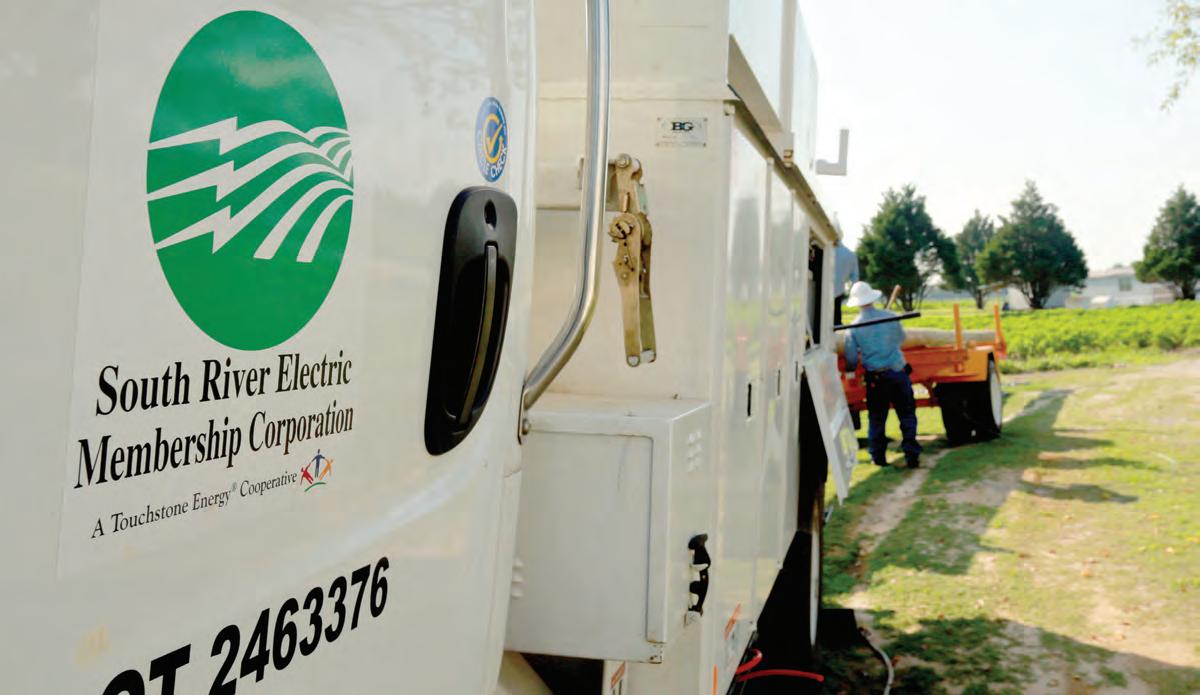
23 minute read
More Power
from 2022-07-SREMC
Smart, Deliberate Grid Management
By Amadou Fall
Our nation’s electric grid — the system of generation plants, transmission lines, substations and distribution lines that deliver power to your home — is a massive, complex machine. And with new, smaller distributed sources of electricity generation and innovative technologies being added to the grid, it’s becoming more complex every day. For many electric utilities, managing this new complexity is a growing challenge, leading to national headlines about cost and reliability concerns.
But in North Carolina, electric cooperatives are getting ahead of that change, working in new ways to ensure we do our job to deliver reliable, affordable and sustainable power to your home. You can think about the work we’re doing on the grid in two categories: there are the new technologies and resources being physically added, and there are new ways to manage those resources and keep them secure. On the physical side, North Carolina’s electric cooperatives receive power from a diverse mix of energy resources, predominantly made up of nuclear generation, natural gas, renewable energy and purchased power. More than half of our power is currently carbon-free, and we have a target to reach net zero carbon emissions by 2050.
Projects supporting this goal while enhancing resilience and reliability include new solar + storage sites across the state, which will generate more than 23 megawatts (MW) of energy (see article on page 5); the installation of cutting-edge battery technology in 10 rural communities; and co-op microgrids at five sites
that are connected to the grid, but can operate independently of it if need be to keep critical services online. On the grid management side, we have developed a cutting-edge capability called the “distribution operator.” (see “A Brighter Future More than half of our Through Grid Management,” August 2021, page 10). This new capability provides a big-picture power is currently view of more than 500 MW of distributed energy resources across all 26 of North Carolina’s eleccarbon-free, and we tric cooperatives, allowing us to coordinate the have a target to reach resources for improved reliability, affordability and sustainability. net zero carbon The key to making all of this successful — to making it be a true benefit to you and electric emissions by 2050. co-op members across the state — is deploying these energy resources at a deliberate, measured pace. In making thoughtful decisions about the grid, we are making strides toward environmental and sustainability goals while keeping reliability our top priority. This summer, as temperatures rise, rest assured that we will be managing the grid through times of high demand, ensuring that the electricity we provide remains a reliable, affordable and sustainable part of your life.
Amadou Fall is COO of the North Carolina Electric Membership Corporation, which provides electricity to 25 member cooperatives in North Carolina.
Electric Co-ops Adding Solar + Storage Across Rural NC

Renewable energy resources will be added at 14 sites
North Carolina’s Electric Cooperatives are bringing new energy innovation to rural North Carolina by coupling utility-scale solar with battery energy storage at 14 locations. The new solar + storage resources will be interconnected to electric cooperative grids and support the cooperatives’ Brighter Future efforts — an initiative to support co-op consumer-members and communities by building a more resilient, efficient grid, while upholding affordability and pursuing a long-term sustainability goal.
“Delivering value to co-op consumermembers and communities is a cornerstone of our cooperative purpose, and solar is a growing resource for us,” said Amadou Fall, COO of North Carolina’s Electric Cooperatives. “Pairing solar with battery energy storage enables us to gain the most benefit from an intermittent resource, advancing grid resilience and supporting our goal of achieving net-zero emissions by 2050.”
“Solar energy is most abundant during the middle of the day. However, peak energy demand typically occurs in the late afternoon hours in the summer and the early morning during the winter,” said John Lemire, director of grid management for North Carolina’s Electric Cooperatives. “With hybrid solar and storage solutions, renewable solar energy is captured when it’s most abundant in large batteries. This energy can then be discharged exactly when it’s needed to efficiently support the grid.”
Cooperatives in North Carolina are working together to integrate innovative energy technologies like solar and storage at a deliberate pace to balance and uphold commitments to reliability, affordability and sustainability. Currently, electric cooperatives have approximately 500 megawatts (MW) of renewable, distributed energy and edge-of-grid resources integrated or pending integration into cooperative grids through their shared role as a “distribution operator.”
As a distribution operator, the state’s electric co-ops are coordinating thousands of distributed energy resources throughout the grid to optimize their performance and support an efficient and strategic grid evolution.
“While cooperative power is already very reliable, this cuttingedge capability enhances reliability even further for co-op members, as power now flows multi-directionally throughout the grid,” Fall said.
14
SOLAR + STORAGE SITES
more than
75,000
SOLAR PANELS more than
53MWh
OF ENERGY STORAGE
will generate more than 23 MW, or enough to power more than
23,000
HOMES
Six developments are already operational: ■ Two sites in Duplin County—Interconnected with Four County EMC ■ One site in Halifax County—Interconnected with Halifax EMC ■ Three sites in Randolph County—Interconnected with Randolph EMC
Eight more expected to be activated by the end of the year: ■ One site in Greene County—Interconnected with Pitt & Greene EMC ■ One site in Hyde County—Interconnected with Tideland EMC ■ Three sites in Northampton County—Interconnected with
Roanoke Electric Cooperative ■ One site in Richmond County—Interconnected with Pee Dee Electric ■ One site in Sampson County—Interconnected with South River EMC ■ One site in Wake County—Interconnected with Wake Electric
July Quick Hits
Safe Celebrations Be careful with fireworks and sparklers— they should only be handled by responsible adults. Visit bit.ly/nsc-fireworks for more safety tips.
Know Your Sunscreen
Use “broad spectrum” sunscreen, which blocks the sun’s UVA and UVB rays, with SPF of 15 or higher.

Tip and Toss Curb your local mosquito population by emptying or getting rid of outside containers that hold stagnating water. Source: NC State
Cool Shades Keep window coverings closed during summer days to block the sun’s heat and help your air conditioner work less. Source: DOE

Tropical Storm Elsa was among those that affected North Carolina in 2021.
Above-Normal Hurricane Season Predicted
The Atlantic hurricane season began June 1 and runs through November, and this season is predicted to be busier than usual. The 2022 Atlantic hurricane season will see up to 21 named storms forming in the Atlantic basin, according to researchers at both NC State University and the National Oceanic and Atmospheric Administration (NOAA). The Atlantic basin includes the entire Atlantic Ocean, the Gulf of Mexico and the Caribbean Sea. The long-term average of named storms is 11.
Of the predicted named storms, seven to nine may grow strong enough to become hurricanes (the historical average is six), with the possibility of three to five storms becoming major hurricanes, according to NC State University.
Although no hurricanes made landfall in North Carolina in 2021, three tropical systems moving through the state — Claudette, Elsa and Fred — brought heavy rainfall, high winds and flooding. Hurricane Ida, which made landfall as a category 4 hurricane in Louisiana in September 2021, impacted communities as far north as New England.
“Hurricane Ida spanned nine states, demonstrating that anyone can be in the direct path of a hurricane and in danger from the remnants of a storm system,” said FEMA Administrator Deanne Criswell. “It’s important for everyone to understand their risk and take proactive steps to get ready now by visiting Ready.gov (Listo.gov en español) for preparedness tips, and by downloading the FEMA App to make sure you are receiving emergency alerts in real-time.”
Be Prepared For Whatever Mother Nature Brings
Whether storm clouds are on the horizon or a hurricane is in the forecast, NCStormCenter.coop is your one-stop-shop for important information to protect you and your family during severe weather. Resources include:
A real-time statewide outage map Information on what to do before, during and after a storm Specific resources for hurricanes, flooding, tornadoes and winter storms
EneryUnited’s Wayne Wilkins Retires After 51 Years of Service
Thomas Golden appointed as next CEO
In May, EnergyUnited CEO Wayne Wilkins retired following a career with electric co-ops that spans decades.
“Over the course of his storied career in the energy industry, Wayne was continually committed to supporting member and community service initiatives that positively impacted so many people,” said EnergyUnited Board Chairman and President Dr. Max Walser. “I am incredibly thankful to have had the opportunity to serve with Wayne and sincerely appreciate all that he has done on behalf of EnergyUnited members.”
Wilkins’ 51-year career with North Carolina’s electric cooperatives includes service as CEO of Davidson EMC, where he helped coordinate the consolidation of it and the neighboring Crescent EMC to form the present-day EnergyUnited, based in Statesville, in 1998. The co-op has since deployed new technologies to better serve members and increase reliability, including advanced metering infrastructure, smart grid technology and electric vehicle chargers.
His service to the electric cooperative network extends to the state level, where he served on the North Carolina Electric Membership Corporation and North Carolina Association of Electric Cooperatives (NCAEC) boards of directors, including providing guidance as NCAEC Board President in 1990 and serving on the NCAEC Executive Committee from 2008–2013. He has worked closely with legislators at the state and national levels, advocating on behalf of the communities served by electric cooperatives across North Carolina, and has supported political action as Chair of the Rural Electric Action Program.
“As I look back and ask myself the question of what I would do different, I don’t think I could’ve picked a better business to be in,” Wilkins told EnergyUnited members ahead of his retirement. “There are just so many incredible people and facets within this job that have pushed me and grown me as a leader, a friend and even a father.” Following the announcement of Wilkins’ retirement, EnergyUnited Board of Directors appointed Thomas Golden to serve as the cooperative’s next CEO.
Golden recently served at the co-op’s COO, where he was responsible for the oversight, implementation and execution of many strategic initiatives that focused on “There are just so developing growth opportunities, operational enhancemany incredible ments, improving member value and maintaining superior safety and reliability performance. He holds a Bachelor people and facets of Science degree in nuclear engineering and engineering within this job that physics from Rensselaer Polytechnic Institute in New York, as well as a Master of Business Administration from have pushed me Wake Forest University. “I am honored to serve EnergyUnited members as the and grown me as cooperative’s CEO,” Golden said. “More than 115,000 a leader, a friend EnergyUnited members trust their cooperative each day to deliver safe, affordable, reliable and environmenand even a father.” tally-responsible energy. While these primary service pillars remain consistent, our members’ expectations will continue to evolve with the implementation of new technologies and innovative solutions. As EnergyUnited’s CEO, I’m excited to lead the cooperative into this future with member satisfaction always top of mind.”

Thomas Golden (left) will serve as EnergyUnited’s next CEO. Retiree and prior CEO Wayne Wilkins spent 51 years working with North Carolina’s electric cooperatives.
VisitNC.com As the son of a commercial fisherman, Beaufort native Carl Cannon, Jr., came by his love of the sea honestly — though some people would say he took a wrong turn along the way. As an adult, Cannon chose a life of pirating. He’s commander of a rowdy band of swashbucklers, mermaids and sailors landing at Gallant’s Channel September 23–25 for this year’s Beaufort Pirate Invasion (beaufortpirateinvasion.com).
“Pirates have gotten a bad rep, but it really depends which side you’re on,” says Carl, who spends his days organizing pirate invasions and volunteering at the Maritime Museum in this seaside town, which is nestled between the outlying Shackleford and Bogue banks.
“Over history pirates are typically robbers and thieves,” Carl adds, then slipping into character: “We are privateers, hired by kings and the wealthy to protect their property from their enemies, and sometimes it’s necessary to appropriate their cargo. We’re the good guys.”
Pirate activity in and around Beaufort harks back to the Golden Age of Piracy, when the infamous Blackbeard ran the Queen Anne’s Revenge aground in Beaufort Inlet in 1718, and in 1747 when Spanish privateers attacked and plundered the small town until local militia finally drove the attackers away.
It was that bit of tumultuous history that inspired the first event in 1960: a reenactment of the invasion performed by the local fire department.
“When I was just a kid, my mom would take me to the original Pirate Invasions, which started here in the early 1960s,” Carl says. “I can remember waiting on the docks for my dad to come home between fishing trips, and when I was pretty young, I was given my first rowboat. So between those early days and our family’s history with the sea, I guess I always dreamed about that kind of life.”
Invasions through the years
Those early Pirate Invasion events of the ’60s were two-hour performances featuring pirate antics and a bit of history, but after several years, interest waned. America’s Bicentennial and the tall ship cruises revitalized it.
“Around that time, well-known pirate Captain Horatio Sinbad joined in the fun for several years, and he and his ship ‘Meka II’ brought a new aspect to the event for a time,” Carl says. “Then we underwent another revival in the 1980s. The pandemic slowed us down, but all in all, we’ve done 48 events since the early 1960s.”
Before Carl took up the pirate life, he was a commercial fisherman and worked on a dredge boat. By 2012, he had purchased and outfitted a sailboat into an 18th-century replica of a pirate ship and began pirating. In 2017, he took over volunteer leadership as president of the Beaufort Pirate Invasion. The festival became a non-profit in 2015 so that it could raise money for charity — last year, the group funded a violin and a cello for the classical music program at East Carteret County High School.


Samantha Taylor Samantha Taylor


Samantha Taylor

Darryl Marsh

Swansboro swashbuckling
In May, Carl’s crew descended on Swansboro in Onslow County for its two-day Pirate Fest.
“There were boats, encampments, cannon firings, sword fights and even a pirate scavenger hunt,” says LaQuesha Cadwallader, recreation program supervisor with Onslow Parks and Recreation, which presented the event with Swansboro Parks and Recreation. “People just really like pirates.”
Event attendees got into the action. “Many of the adults and kids came dressed up like pirates,” Director of Swansboro Parks and Recreation Anna Stanley says. “And the invasion on the water with the battle between the ships is amazing. It’s one of my favorite annual events here.”
Upcoming piracy
In September, Carl and his pirate crew of nearly 40 will sail into Gallants Channel and set up their encampment on its shores, living the pirate life throughout the three-day festival. Battles between pirate ships, living history displays and reenactments, sword fights, mermaids, lady pirates and black-powder demonstrations bring the past alive.
The Motley Tones, Thunder and Spice and The Crossjacks set a pirate-style musical backdrop for magicians, stilt walkers, the Creative Flame fire dancers, peg-legged buccaneers, blacksmiths and axe-throwers.
“It’s our mission to keep the tradition alive with our pirate invasion events up and down the Atlantic Coast, showcasing the fun and history of this oft-maligned lifestyle,” he says. “Once you get to know us, you’ll find that our pirate crews are a friendly bunch who only pick up a sword when necessary, fire our cannons to demonstrate our might — and are a lot more bark than bite.”
Carl Cannon, Jr. (right), with Michael Taylor (aka Brax) at a past event
Pamela A. Keene is a freelance journalist who writes for magazines and newspapers across the Southeast and nationally.

The storied lives of Anne Bonny and Mary Read

By Donna Campbell Smith
Carolina colonial history is full of stories of pirates, evil men who preyed on unarmed vessels along the Atlantic coast. Sometimes the line between honest seaman and pirate was a fuzzy one. Perhaps the fuzziest line of all was drawn in the case of two pirates who sailed under the black flag of “Calico Jack” Rackham, who countered the typical image of a pirate — not because of what side of the law they were on, but because of their gender. They were the lady pirates Anne Bonny and Mary Read.
This dastardly duo were among a very few female pirates in recorded history, and most of what we know about them is drawn from the 1724 book, “A General History of the Pyrates.”
Anne Bonny
Anne Cormac was born in Ireland in 1702, the illegitimate daughter of William Cormac and his servant, Mary Brennan.
Cormac later sailed with his lover and baby to America. They settled near what is now Charleston, South Carolina. When Anne was a teenager, her mother died. Anne became manager of their plantation. She had a hot temper; legend tells she beat a man nearly to death with a chair when he made unwanted advances.
Fed up with the genteel life of the colonial South, she married James Bonny, who was known to dabble in pirating. That is how Anne met the pirate Calico Jack. They became lovers, and she ran off to sea with him. Anne gave birth to Jack’s child while they were in Cuba. (It is believed they left the baby with friends and went back to sea.)
By now, Anne was a full-fledged member of the crew. She dressed in men’s clothing, probably at Jack’s request. She was handy with sword and pistol, and quick to use them.
Anne next fell for one of Jack’s crewmen. Although in a twist fit for a swashbuckling movie script, Anne soon learned that fellow crewman “Mark” Read was also a female disguised in men’s clothing.
Mary “Mark” Read
Mary Read (aka Mark), began life differently than Anne. Born in England, she was disguised as a boy from infancy. Her widowed mother pretended Mary was a boy to receive a death benefit not otherwise available to a girl child.
When Mary was older, Mrs. Read hired her daughter out as a footboy. It wasn’t long before Mary tired of that job and ran away. She took on a position with a British man-of-war and later joined the army as a soldier.
Mary, still believed to be a man by all, fell in love with a fellow soldier. They kept her gender a secret until after their time with the army, at which point they became publicly married. Mary and her husband lived a normal and happy life running a tavern.
Then, Mary’s husband died. She failed with the tavern business and returned to the life she knew best. Disguised as a man she joined an army in Holland. Later she took a position on board a ship sailing for the West Indies.
Pirates, led by Calico Jack, attacked the merchant ship, and Mary was taken prisoner. From that time on, Mary was a pirate.


Divergent fates
It wasn’t long before Mary and Anne became aware that they were each a woman. Calico Jack, none the wiser at first, became jealous of “Mark” and threatened to slit his throat. Anne had to let him in on her and Mary’s secret.
But the drama didn’t end there. Mary had an affair with another crewman and became pregnant. Meanwhile, Calico Jack’s ship was captured, and the pirates were put on trial. The men were all sentenced to hang, with Jack scheduled to die the next day. He asked to see his beloved Anne before his execution, but if he’d hoped for sympathy, he got none. As Anne succinctly put it: “I am sorry to see you in this predicament, but had you fought like a man, you would not have to die like a dog.”
Mary and Anne were tried, however, both were pregnant at the time and since a pregnant woman could not receive the death penalty, their sentences were delayed.
Mary, however, died while in prison. Anne’s fate was unknown until the twentieth century, when a rumor surfaced that her name was found in a family Bible, along with a birth certificate and some letters. The birth certificate named a boy child, John Cormac Bonny, whose father was named as John Rackham.
If this rumor is true, it supports the theory that Anne’s father bought her pardon and sent her back to the Carolinas. Some believe Anne Bonny married a man named Joseph Burleigh, lived to a ripe old age and is buried in Virginia. But to this day, how Anne truly spent her later years remains a mystery.
Anne Bonny (left) and Mary Read
Strong storms. Stronger network.

Co-op ingenuity and innovation are adding strength and flexibility to our grid. Coupled with the dedication of crews from home and afar, cooperatives are ready for whatever summer weather brings.
Truth or Fiction: Top Misconceptions About Snakes

Are snakes as scary as we make them seem?
By Rue Reynold Timber Rattlesnake
Snake season is in full bloom, which means sightings will be more common and you may find an unwanted visitor a little too close to home. Don’t worry, though. Many of the scary encounters we hear about are the exception, not common occurrences. So before you panic and wish a snake’s demise, familiarize yourself with these snake myths and facts.
Myth: All snakes are poisonous Snakes can only be poisonous — meaning toxic to eat — if their diet includes prey with highly toxic qualities. North Carolina snakes do not have this kind of diet, so they are not poisonous. Some species of snakes, however, inject venom into prey or perceived threats with their fangs. These snakes are venomous. Of the 38 species of snakes in North Carolina, only six are venomous, according to the NC Wildlife Resources Commission. These snakes are the copperhead, cottonmouth, Eastern coral snake, Eastern diamondback rattlesnake, pigmy rattlesnake and timber rattlesnake
Myth: Snakes are aggressive Snakes get a bad reputation because we almost always hear about attacks and nothing more. Snakes are actually scaredy cats and will likely run away or lie still if they see you. Snakes will run, hiss and maybe even huff before they ever think about biting you. The only exception is if they’re frightened or roughly handled. Even then, behavior of threatened snakes is defensive rather than aggressive.
Truth: Snakes are master escape artists Every snake owner will attest to the escaping skills of a snake. That’s why you’ll almost always hear about the need to secure your snake’s home, whether they’re in tubs, glass tanks or enclosures with sliding doors. Locks are advised to keep your little Houdini in place. Myth: Snakes will chase you If snakes are suddenly disturbed by a human, most of these reptiles will instinctively bolt to the nearest escape route. Coincidentally, this route may be the same path you chose to run down as well. So if you see a snake is “chasing” you, it likely just shared your feelings about escaping a “scary” creature.
Myth: Snakes “size up” prey before eating it Snakes are opportunistic eaters. If they’re hungry and see prey, they’ll instantly charge at it.
What to do if you see a snake If you want to get rid of a snake basking in your yard or napping under your porch chair, the NC Wildlife Resources Commission recommends gently spraying the snake with water from a safe distance. It’ll slither away and likely won’t be back — a happy ending for the both of you.
Remember, venomous or not, snakes are laid-back creatures that usually leave you alone if you leave them alone. Snakes don’t stay in one spot for long, so the best way to avoid attacks is to leave snakes alone and mind where you step when out and about.
Visit ncwildlife.org/Conserving/Species for more information about North Carolina’s snakes with identifiable photos and suggestions on how to help prevent snakes from being on your property.
Money-Saving Tips While on Vacation

Four ways to give your wallet a break, too
By Rue Reynold
Summertime is vacation time, and that means taking a trip with loved ones or having a relaxing getaway for yourself. However, when something you can’t pass up comes along and takes a stab at your wallet, you can’t help counting numbers instead of enjoying the moment. Here are four tips to help you save a dime even if your plans are already in motion.
1. Plan “spontaneous” visits Visiting places on a whim can do more harm than good if costs are higher than expected. Research prices of nearby restaurants or attractions before heading out.
2. Avoid eating out so often Dining out can add up quickly, so take advantage of complimentary hotel meals or cook something up yourself for a taste of home while saving a dollar. 3. Set a spending limit per store New places make it difficult to resist buying one, two or three souvenirs to remember the experience. That’s great until you buy three items from 15 different stores. Set a budget, such as a set amount for every shop you visit, to keep spending in check.
4. Spend more time outside Most places have outdoor attractions or stunning structures you can indulge in by simply walking around. Free of charge. Parks, lakes, sculptures, historic buildings — the list goes on, and your wallet doesn’t have to suffer for it.
Not spending an arm and a leg can be tough when you’re on vacation, but with these money-saving tips, you can enjoy each new experience to the fullest.
Rue Reynold is the editorial assistant for Carolina Country.
Love Carolina Country? Don’t miss an issue!
Subscribe and get Carolina Country in your mailbox every month for just $1 an issue!
Co-op Members, check with your electric cooperative to find out if they offer complimentary subscriptions as a benefit of membership.
Yes! Please start my subscription.
NAME
MAILING ADDRESS
CITY STATE ZIP
PHONE NUMBER (If we have questions)
1 Year (12 issues) $12 2 Years (24 issues) $24 Check Enclosed Scan to Subscribe!
South River EMC Communicator

SMALL CHANGE, BIG IMPACT
In 2007, many South River EMC members began allowing their electric bill to be rounded up to the next dollar monthly as part of Operation Round Up.

Those funds have gone to over 160 nonprofit organizations and schools since 2008, and have had a huge impact on our communities.

Lauren Strickland is the media coordinator at Hargrove Elementary. She has received 12 grants for the school. Lauren Strickland at Hargrove Elementary
“Operation Round Up has funded thousands of dollars in much-needed books for Hargrove’s library. It is a constant battle to keep the library up to date with new and interesting books for students, and Operation Round Up has made this process 10 times easier,” said Strickland.
Nonprofit organizations like the Averasboro Battlefield Commission, have used their multiple Operation Round Up grants to improve their facilities.
INSIDE THIS ISSUE
South River EMC offices will be closed Monday, July 4, in celebration of Independence Day.
Member Satisfaction
Fields of Honor
Linemen Render Aid
Energy Savers








